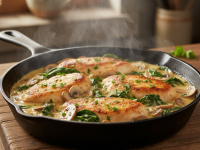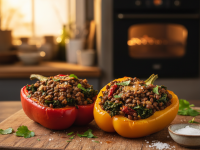Hey there, fellow food enthusiasts! Have you ever stumbled upon an ingredient that completely redefines your perception of comfort food? For me, that ingredient was the humble yet mighty pumpkin leaf. Yes, you heard that right – pumpkin leaves! Often overlooked, especially in Western cooking, these vibrant green leaves are a powerhouse of flavor and nutrition, forming the heart of many cherished traditional dishes across Africa and Asia.
Today, I want to take you on a culinary journey, sharing my absolute love for pumpkin leaf soup. This isn’t just any recipe; it’s a blend of time-honored tradition and a fresh, modern twist that I’ve lovingly developed in my own kitchen. Imagine a soup that’s deeply nourishing, incredibly flavorful, and surprisingly easy to make. Get ready to transform those often-discarded leaves into your new favorite healthy comfort food!
My Journey with Pumpkin Leaf Soup: A Culinary Revelation
My first encounter with pumpkin leaf soup was, admittedly, a bit hesitant. I was visiting a friend whose family hailed from West Africa, and when a steaming bowl of what looked like a dark green stew was placed before me, I wasn’t quite sure what to expect. My friend, sensing my trepidation, just smiled and said, “Trust me, it’s delicious. It’s ‘Ugu’ soup.” Taking that first spoonful was a revelation! The flavors were earthy, savory, slightly bitter in the most pleasant way, and incredibly comforting. It tasted like home, even though it was completely new to me.
From that day on, I was hooked. I delved into learning about this incredible ingredient and its many variations. I discovered that pumpkin leaves, known as ‘Ugu’ iigeria, ‘Kalabasa’ leaves in the Philippines, or simply ‘pumpkin greens’ elsewhere, are culinary treasures. They’re not just a source of food; they’re a coection to culture, family, and sustainable cooking. My initial skepticism quickly turned into a passion, and I started experimenting, aiming to capture that authentic taste while adding my own creative touches to make it a dish I could easily whip up in my modern kitchen.
Understanding the Star Ingredient: Pumpkin Leaves
Before we dive into the recipe, let’s talk about our star: pumpkin leaves. Not all leaves from pumpkin plants are created equal, but generally, the tender young leaves and shoots of most edible pumpkin varieties are perfectly safe and delicious to eat. You’re looking for vibrant green leaves, free from blemishes, and ideally, those that are still quite supple, not tough or leathery.
Where to Find Them:
- Your Garden: If you grow pumpkins, you have a goldmine! Harvest the younger leaves and the tips of the vines.
- Farmers Markets: Often, you can find them at markets specializing in African, Asian, or Caribbean produce.
- Specialty Grocers: Some larger international supermarkets might carry them.
Nutritional Powerhouse:
Pumpkin leaves are more than just flavor; they’re packed with goodness! They’re an excellent source of vitamins A, C, and K, as well as essential minerals like iron, calcium, and potassium. Plus, they’re loaded with dietary fiber, making them fantastic for digestion and overall health. So, you’re not just eating something delicious; you’re nourishing your body too.
Preparation is Key:
Preparing pumpkin leaves is straightforward but requires a little attention:
- Wash Thoroughly: Rinse them under cold ruing water to remove any dirt or insects.
- Remove Fibrous Strands: This is the crucial step. Many pumpkin leaves have thin, fibrous strands along the stem and sometimes on the main vein of the leaf. Simply hold the stem end, snap it, and gently pull downwards to remove these strings. It’s similar to stringing green beans. If the leaves are very young and tender, this step might not be necessary.
- Chop: Once cleaned and de-fibered, stack a few leaves and finely chop them. The finer you chop, the quicker they’ll cook and blend into the soup.
The Traditional Essence: What Makes It Authentic?
Traditional pumpkin leaf soups, especially those from West Africa, often rely on a few core ingredients and techniques that give them their signature depth and richness. Think of ingredients like:
- Palm Oil: This gives the soup a distinctive reddish hue and a unique, earthy flavor.
- Smoked Fish or Meat: Essential for a robust umami kick.
- Prawns or Crayfish: Another layer of seafood flavor.
- Stock: Typically water or a basic meat stock.
- Aromatics: Onions, peppers (like habanero or scotch boet for heat), and sometimes garlic.
- Thickening Agents: Ground egusi (melon seeds) is very common iigerian Ugu soup, lending a nutty flavor and creamy texture.
The cooking method usually involves sautéing the aromatics, adding the protein, simmering with stock, and finally incorporating the chopped leaves, often with a thickening agent, until everything is tender and the flavors have beautifully melded. It’s a process that builds layers of incredible taste.
Adding the Modern Twist: Elevating Your Soup Game
While I deeply respect and adore the traditional methods, my modern twist focuses on enhancing the flavors, boosting the nutritional profile, and making the recipe adaptable for various dietary needs, all without losing its authentic soul. Here’s how we’re going to elevate this beautiful dish:
1. Richer Base, Brighter Notes:
- Bone Broth/Quality Veggie Stock: Instead of just water, I use a high-quality bone broth for a more nutritious and flavorful base, or a rich homemade vegetable stock for a vegetarian version.
- A Squeeze of Citrus: A little lime or lemon juice added at the very end brightens all the flavors and adds a fantastic zing that cuts through the richness.
2. Creaminess Without the Heaviness:
- Coconut Milk: For a luscious, creamy texture and a hint of subtle sweetness, I love adding a splash of full-fat coconut milk (or a lighter version if preferred). It complements the earthy leaves beautifully and makes the soup incredibly velvety. For a dairy-based option, a swirl of Greek yogurt can also work wonders at the end.
3. Elevated Aromatics & Spices:
- Ginger & Garlic Paste: Beyond just onions, I sauté a small amount of fresh ginger and garlic paste at the begiing. This adds a wonderful aromatic depth.
- Smoked Paprika: If you’re not using palm oil, a pinch of smoked paprika can give you a hint of that earthy smokiness and a lovely color without the specific taste of palm oil.
- A Touch of Curry Powder or African Suya Spice: Depending on my mood, a tiny dash can introduce another layer of warmth and complexity.
4. Diverse Protein Options:
While smoked fish is traditional, I often branch out:
- Grilled Chicken or Shrimp: Lightly grilled pieces added towards the end for a leaner protein.
- Crumbled Tofu or Lentils: For a fantastic plant-based protein option that absorbs the soup’s flavors wonderfully.
- A Poached or Fried Egg: Serving a bowl of this soup with a perfectly cooked egg on top adds a decadent, ruy yolk goodness that makes it a complete meal.
5. Texture Play & Garnish:
- Toasted Nuts/Seeds: A sprinkle of toasted pumpkin seeds, cashews, or even crushed peanuts adds a delightful crunch.
- Fresh Herbs: A scattering of fresh cilantro or basil leaves right before serving adds freshness and visual appeal.
- Chili Oil: For those who love heat, a drizzle of homemade chili oil on top takes it to another level.
My Go-To Recipe: Traditional Meets Modern Harmony
Alright, let’s get cooking! Here’s my favorite rendition of Pumpkin Leaf Soup, blending tradition with those delightful modern twists.
Yields: 4-6 servings
Prep time: 20 minutes
Cook time: 30 minutes
Ingredients:
- 300g (about 6-8 cups packed) fresh pumpkin leaves, cleaned, de-fibered, and finely chopped
- 2 tablespoons olive oil (or palm oil for a more traditional flavor)
- 1 large onion, chopped
- 2-3 cloves garlic, minced (or 1 tsp garlic paste)
- 1 inch fresh ginger, grated (or 1 tsp ginger paste)
- 1-2 scotch boet peppers (or habanero), minced (adjust to your spice preference)
- 500g protein of choice (e.g., smoked mackerel, raw shrimp, diced chicken breast, or crumbled firm tofu)
- 4 cups rich chicken or vegetable broth (or bone broth)
- 1/2 cup full-fat coconut milk (optional, for creaminess)
- 1/4 cup ground pumpkin seeds or ground egusi (optional, for thickening and nutty flavor)
- Salt to taste
- Black pepper to taste
- Juice of 1/2 lime or lemon
- Optional garnishes: toasted pumpkin seeds, fresh cilantro, chili oil
Instructions:
- Prepare Ingredients: Ensure your pumpkin leaves are thoroughly cleaned, de-fibered, and finely chopped. Have all other ingredients measured and ready. If using chicken or tofu, season it lightly with salt and pepper.
- Sauté Aromatics: Heat the olive oil (or palm oil) in a large pot or Dutch oven over medium heat. Add the chopped onions and sauté until softened and translucent, about 5-7 minutes.
- Add Heat & Flavor: Stir in the minced garlic, grated ginger, and minced scotch boet pepper. Cook for another 2-3 minutes until fragrant, being careful not to burn the garlic.
- Cook Protein: If using chicken or shrimp, add it to the pot and cook until it’s lightly browned or almost cooked through. If using smoked fish, you can add it now or later in step 5 to prevent it from breaking apart too much. If using tofu, crumble it in and sauté until slightly firm.
- Build the Soup Base: Pour in the chicken or vegetable broth. Bring the mixture to a gentle simmer. If using ground pumpkin seeds or egusi for thickening, whisk it with a little water to form a paste, then stir it into the simmering broth.
- Add Pumpkin Leaves: Carefully stir in the finely chopped pumpkin leaves. They will look like a lot but will wilt down significantly. Cook for 5-7 minutes, or until the leaves are tender but still retain their vibrant green color. Be careful not to overcook them!
- Introduce Creaminess & Season: If using, stir in the coconut milk. Season the soup with salt and black pepper to taste.
- Finishing Touch: Remove the pot from the heat. Stir in the fresh lime or lemon juice. Taste and adjust seasoning if needed.
Serving Suggestions & Enjoyment
Your delicious pumpkin leaf soup is ready to be enjoyed! This soup is incredibly versatile. I love serving it piping hot with a side of fluffy white rice, a traditional African staple like fufu or eba, or simply with some crusty bread to soak up every last drop. For a lighter meal, it’s perfect on its own. Don’t forget those optional garnishes – a sprinkle of toasted pumpkin seeds and a few fresh cilantro leaves truly elevate the experience.
Leftovers, if you have any, taste even better the next day as the flavors deepen. Store them in an airtight container in the refrigerator for up to 3-4 days. This soup also freezes well, making it perfect for meal prepping!
Conclusion
From a hesitant first bite to becoming a cherished recipe in my culinary repertoire, pumpkin leaf soup has taken me on an incredible journey. It’s a testament to the fact that some of the most overlooked ingredients can yield the most comforting and nutritious dishes. By embracing its traditional roots and infusing it with a few modern touches, we’ve created a soup that is not only packed with flavor and health benefits but also deeply satisfying and incredibly versatile.
So, I encourage you to step out of your culinary comfort zone and give this pumpkin leaf soup a try. You might just discover a new favorite, a dish that coects you to global flavors and the joy of wholesome, homemade food. Happy cooking, and enjoy every spoonful!




